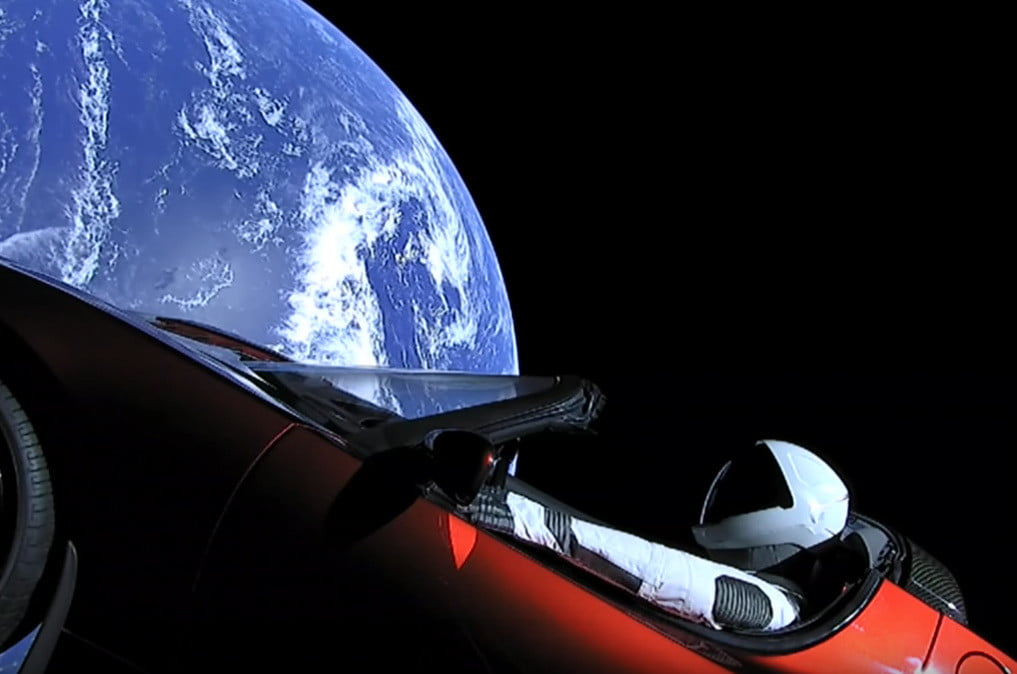It’s been 11 days since the Falcon Heavy took off from Cape Canaveral and brought with it amazing photos of Starman floating through space (see photo below). But what’s next for the Falcon Heavy? More importantly, how does the Falcon Heavy shake up our ability for deep space exploration?
In a space enthusiasts mind, humans reaching Mars is the ultimate goal, but that journey is still in its infancy. Political discourse, lack of focus, and budgetary concerns have left both government organizations and private industry sorely out of reach. For some perspective, the Apollo program ended 46 years ago and since then humans haven’t left low Earth orbit (LEO). After Apollo ended the Space Shuttle dominated low earth orbit until the vehicles retirement in 2011. Since then, every new launch vehicle has slowly increase the lift weight or volume into LEO. The main competitors are: Ariane 5, Delta IV Heavy, Long March 5, and Proton M. But these launch systems don’t have enough lift capacity and are too cost to satisfy NASA’s needs beyond LEO.
Now enter the next generation of heavy launch vehicle, the Falcon Heavy. At more than half the cost of the next largest capacity lift vehicle, the Delta IV heavy, the ability to go deeper into space just got drastically cheaper, try $250 Million cheaper. Let’s not forget that the Delta IV heavy has the capacity to take a crew capsule past LEO (albeit empty), it did in 2014 with NASA’s Orion capsule but at a much higher cost. NASA is currently developing Space Launch Systems (SLS) to be the governments large capacity launch vehicle, about 290,000 lbs to LEO, but will be magnitudes more expensive than the Falcon heavy, which has the ability to move 140,000 lbs to LEO.
Starman sporting a Tesla Roadster shortly after launch
So, what’s next?
Does NASA shut down it’s new vehicle production and use the Falcon Heavy to launch its astronauts? Using the Falcon Heavy would certainly be cheaper than relying on SLS. The Falcon Heavy, however, has a lower lift capacity and that will mean an increased number of launches, if the same amount of cargo is to be moved. That creates a problem, future satellites and space structures are going to be assembled in space. The current deep space exploration plan by NASA has Deep Space Gateway (DSG) and Deep Space Transport (DST) to be assembled around the Moon. DSG and DST will be constructed using robotics and will be complex. With the Falcon Heavy smaller cargo capacity, it will mean more components will be be launched and assembled compared to SLS. Robotic space structure construction may prove to be more difficult with an increased number of parts. More launches certainly brings more complexity to the overall mission.
Outside of NASA’s own vehicles, NASA has only trusted the Soyuz to carry Astronauts into space. The Soyuz has been an active launch vehicle for Russia and the Soviet Union since 1966 and has a good launch history. If the goal is Falcon Heavy to launch astronauts, what will the launch requirements be for NASA to allow for SpaceX to take over?
Before the Falcon Heavy can be considered for certified to launch astronauts, SpaceX is getting the vehicle a certification with the Air Force. As part of the certification process, the Air Force will do a technical evaluation and detailed analysis of the rocket and review the company’s manufacturing and systems engineering processes. Data from the rocket’s flight history is evaluated to make sure it performs as expected. The Space and Missile Systems Center said it could require anywhere from two to 14 flights during the certification process. For example, one launch needs to demonstrate the rocket’s capability by hoisting several satellites and spacecraft into different orbits, this test, labeled Air Force’s STP-2 mission, is scheduled for June of this year. The certification will be a great step to launch larger payloads for the Air Force but this not be enough for NASA, especially when astronauts are on board. NASA switching over full control of launch operations to private industry makes economic sense but it’s a crossroads that has been in the making for years.
If full launch operations are given to the private industry, some may say, “What will NASA then do?”. Easy answer. Do all the research and development that is required for humans to survive deep space and live on Mars.
Note: Opinions expressed are those of the author and not of NASA.


